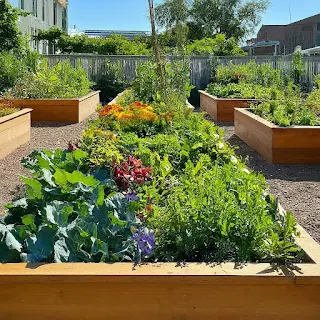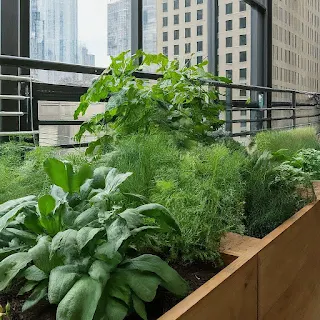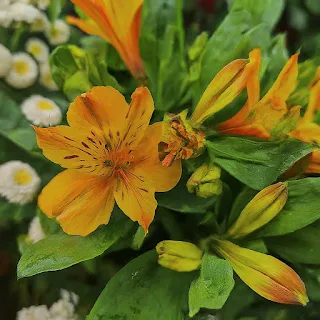Urban Gardening Made Easy: Tips, Plants, and Benefits for Sustainable City Living
Greening Concrete Jungles: A Comprehensive Guide to Sustainable Urban Gardening
 |
| Sustainable Urban Garden |
As urbanisation spreads, city dwellers are increasingly seeking ways to reconnect with nature. Sustainable urban gardening offers an excellent solution by transforming concrete environments into green, vibrant spaces. This practice not only enhances the aesthetic appeal of urban areas but also promotes environmental sustainability and personal well-being. This comprehensive guide explores tips for starting an urban garden, recommends the best plants for small spaces, and highlights the benefits of vertical gardening in urban settings.
Tips for Starting an Urban Garden
1. Evaluate Your Space
 |
| Evaluation of space for gardening |
The first step in creating an urban garden is to assess the space you have available. Urban gardens can thrive in various locations, including balconies, rooftops, window sills, and even unused walls. Measure your space and observe the amount of sunlight it receives throughout the day. Sunlight is crucial for the growth of most plants, so identifying sunny spots will help you decide what to plant and where.
**2. Choose the Right Containers**
 |
| Right container for plants |
Containers are essential for urban gardening. They come in various shapes and sizes, allowing you to utilise every inch of your space efficiently. Traditional pots, hanging baskets, window boxes, and even repurposed items like old buckets or crates can serve as plant containers. Ensure your chosen containers have adequate drainage to prevent waterlogging, which can harm plant roots. Self-watering containers can be particularly useful, especially if you are frequently away from home.
3. Select High-Quality Soil
 |
| High Quality Soil |
Soil quality significantly impacts plant health. Opt for high-quality potting soil, which provides the right balance of nutrients, aeration, and drainage. Enhancing your soil with compost or organic matter can improve its fertility, helping your plants to thrive. Regularly checking and amending the soil can maintain its quality over time.
4. Implement Smart Watering Practices
 |
| Smart Watering practice |
Urban gardens can dry out quickly due to the limited soil volume in containers. Efficient watering practices are essential to keep your plants healthy. Consider using self-irrigating containers or adding a layer of mulch to retain moisture. Water your plants early in the morning or late in the evening to minimise evaporation. Installing a drip irrigation system can also ensure your plants receive consistent moisture without overwatering.
5. Start with Easy-to-Grow Plants
 |
| Easy to grow plants |
If you are new to gardening, it is wise to start with plants that are easy to grow and maintain. Herbs such as basil, mint, and rosemary are excellent choices for beginners. They grow well in containers, require minimal care, and can be used fresh in your cooking. As you gain more experience and confidence, you can gradually diversify your plant selection.
**6. Plan for Year-Round Gardening**
 |
| Plants for year-round gardening |
 |
| Peruvian Lilly |
Urban gardening does not have to be limited to the warmer months. With careful planning, you can enjoy fresh produce year-round. Choose a mix of annual and perennial plants to ensure continuous growth. Additionally, consider investing in a small greenhouse or using cold frames to protect your plants during the colder months. Seasonal crop rotation can also keep your garden productive and soil healthy.
Best Plants for Small Spaces
When space is at a premium, selecting the right plants is crucial. Here are some of the best options for small urban gardens:
1. Herbs
 |
| Herbs |
Herbs are ideal for small spaces and can be grown in pots on window sills or balconies. Varieties like basil, parsley, thyme, and chives not only thrive in containers but also offer culinary benefits. They require minimal maintenance and can be harvested regularly, providing fresh flavours for your meals.
2. Leafy Greens
 |
| Leafy green plant |
Leafy greens such as lettuce, spinach, and kale are quick-growing and can be harvested multiple times. They do not require deep soil, making them perfect for shallow containers. Regularly harvesting these greens encourages new growth, ensuring a continuous supply of fresh, nutritious leaves.
3. Tomatoes
 |
| Tomato plant |
Cherry tomatoes are particularly well-suited to urban gardening. They can be grown in pots or hanging baskets, producing abundant yields in a compact space. Opt for dwarf or determinate varieties, which are designed to grow in confined areas. With proper support, such as stakes or cages, tomato plants can flourish even in small gardens.
4. Peppers
 |
| Pepper plant |
Both sweet and hot peppers can thrive in containers, provided they receive ample sunlight and consistent watering. They are relatively low-maintenance and can add vibrant colours and flavours to your garden. Varieties like bell peppers, jalapeños, and chilli peppers are popular choices for urban gardeners.
5. Strawberries
 |
| Strawberry plant |
Strawberries are excellent for vertical gardening and can be grown in hanging baskets or tower planters. This method maximises space and makes harvesting easy. Strawberries prefer sunny spots and well-drained soil, and with proper care, they can produce delicious fruit throughout the growing season.
6. Dwarf Fruit Trees
 |
| Dwarf fruit plant |
Dwarf fruit trees such as apple, peach, and citrus can be grown in large pots, bringing the joy of home-grown fruit to small urban spaces. These trees are specially bred to remain small while producing full-sized fruit. Ensure they have sufficient sunlight and regular feeding to promote healthy growth and fruit production.
Benefits of Vertical Gardening in Urban Areas
 |
| Indoor and outdoor Vertical garden |
Vertical gardening is a technique that involves growing plants upwards, using structures like trellises, towers, or walls. This method offers numerous benefits, particularly in urban areas where horizontal space is limited.
1. Maximises Space
Vertical gardening allows you to utilise vertical surfaces, such as walls and fences, effectively increasing your gardening area without taking up additional floor space. This is particularly beneficial in small apartments or homes with limited ground space. By growing plants vertically, you can create a lush, green environment even in the smallest of spaces.
2. Improves Air Quality
Plants act as natural air purifiers, absorbing carbon dioxide and releasing oxygen. By incorporating vertical gardens, you can enhance air quality in and around your home. This is especially important in urban areas, where air pollution can be a significant issue. Vertical gardens can help filter out pollutants and improve the overall air quality, contributing to a healthier living environment.
3. Enhances Aesthetics
Vertical gardens can transform dull walls and fences into vibrant, green landscapes. They add a touch of nature and beauty to urban settings, making living spaces more pleasant and inviting. A well-designed vertical garden can serve as a stunning focal point, adding both visual appeal and a sense of tranquillity to your home.
4. Increases Yield
Growing vertically can increase your garden’s yield without occupying additional ground space. Plants like beans, peas, and strawberries thrive when grown upwards, and vertical structures can support more plants in a smaller area. This method also makes harvesting easier, as fruits and vegetables are more accessible when grown at eye level.
5. Reduces Urban Heat Island Effect
Urban areas often experience higher temperatures than their rural counterparts, a phenomenon known as the urban heat island effect. Vertical gardens can help mitigate this by providing shade and releasing moisture through a process called transpiration. This cooling effect can lower temperatures in and around your home, making your living environment more comfortable.
6. Promotes Biodiversity
Vertical gardens can support a diverse range of plants, including flowers, herbs, vegetables, and even small fruit trees. By cultivating a variety of plants, you create a more biodiverse environment that attracts beneficial insects, birds, and pollinators. This not only enhances the ecological health of your garden but also contributes to the broader urban ecosystem.
7. Efficient Use of Water
Vertical gardening can lead to more efficient use of water. Gravity naturally directs water downwards, ensuring that lower plants receive moisture from higher ones. This reduces water waste and ensures that all plants receive adequate hydration. Additionally, vertical gardens can incorporate drip irrigation systems, further enhancing water efficiency.
8. Accessibility and Ease of Maintenance
Vertical gardens are often easier to maintain than traditional horizontal gardens. Plants grown at eye level or higher are more accessible for pruning, harvesting, and pest control. This can be especially beneficial for elderly gardeners or those with limited mobility, making gardening a more inclusive activity.
Conclusion
Embarking on a sustainable urban gardening journey can transform your living space into a green oasis, offering a host of environmental and personal benefits. By following these tips for starting an urban garden, selecting the best plants for small spaces, and embracing the advantages of vertical gardening, you can create a thriving garden in the heart of the city. Urban gardening not only provides fresh, home-grown produce but also contributes to a healthier, more sustainable urban environment.
For more tips and ideas on urban gardening and sustainable living, stay tuned to Eco Urbanite. We are here to help you cultivate a greener, more vibrant urban life. Happy gardening!
---
 |
| Urban garden |
 |
| Rooftop garden |
 |
| Community Garden |
 |
| Rooftop gardening |
 |
| Sustainable Urban garden |












0 Comments:
Post a Comment